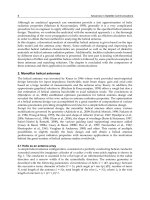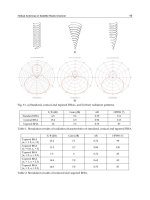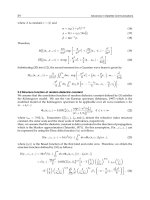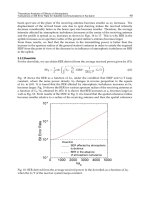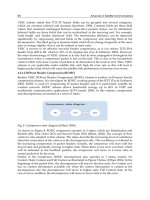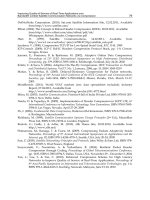Advances in Satellite Communications Part 7 pdf
Bạn đang xem bản rút gọn của tài liệu. Xem và tải ngay bản đầy đủ của tài liệu tại đây (542.41 KB, 15 trang )
Improving Quality-of-Service of Real-Time Applications over
Bandwidth Limited Satellite Communication Networks via Compression
79
DotNetNuke Corporation. (2010). Sat.com Satellite Information Site, 12.02.2011, Available
from
Effnet. (2004). The Concept of Robust Header Compression, ROHC, 20.02.2011, Available
from
Whitepaper_Robust_Header_Compression.pdf
Hart, D. (1997). Satellite Communications, 14.02.2011, Available from
Jacobson, V. (1990). Compression TCP/IP for Low-Speed Serial Link, RFC 1144, 1990
JCP-Consult. (2008). JCP-C RoHC Headers Compression Protocol Stack, pp. 1-9, Cesson-
Sevigne, France
Jeannot, E.; Knutsson, B. & Bjorkman, M. (2002). Adaptive Online Data Compression,
Proceedings of 11
th
IEEE International Symposium on High Performance Distributed
Computing, pp. 379, ISBN 0-7695-1686-6, Edinburgh, Scotland, July 24-26, 2002
Krintz, C. & Sucu, S. (2006). Adaptive On-The-Fly Compression, IEEE Transaction on Parallel
and Distributed Systems, Vol.17, No. 1, January, 2006, pp. 15, ISSN 1045-9219
Matias, Y. & Refua, R. (2005). Delayed-Dictionary Compression for Packet networks,
Proceedings of 24
th
Annual Joint Conference of the IEEE Computer and Communications
Societies, pp. 1443-1454, ISBN 0-7803-8968-9, Miami, Florida, USA, March 13-17,
2005
MindBranch. (2011). World VSAT markets (raw data spreadsheet included): Industry
Report, 07.04.2011, Available from
Mitra, M. (2005). Satellite Communication, Prentice-Hall of India Private Ltd, ISBN 978-81-203-
2786-3, New Delhi, India
Naidu, D. & Tapadiya, R. (2009). Implementation of Header Compression in 3GPP LTE, 6
th
International Conference on Information Technology: New Generations, ISBN 978-0-7695-
3596-8, Las Vegas, Nevada, April 27-29, 2009
Pu, I. (2006). Fundamental Data Compression, Butterworth-Heinemann, ISBN 978-0-7506-6310-
6, Burlington, Massachusetts
Richharia, M. (1999). Satellite Communication Systems: Design Principles (2
nd
Ed.), Macmillan
Press Ltd, ISBN 0-333-74722-4, London, England
Roelofs, G.; Gailly, J. & Adler, M. (2010). zlib Home Site, 20.02.2010, Available from
Shimamura, M.; Ikenaga, T. & Tsuru, M. (2009). Compressing Packets Adaptively Inside
Networks, Proceedings of 9
th
Annual International Symposium on Applications and the
Internet, pp. 92, ISBN 978-1-4244-4776-3, Seattle, USA, July 20-24, 2009
Sun, Z. (2005). Satellite Networking: Principles and Protocols, John Wiley & Sons Ltd, ISBN 978-
0-470-87027-3, West Sussex, England
Suryavanshi, V.; Nosratinia, A. & Vedantham, R. (2004). Resilient Packet Header
Compression through Coding, Proceedings of Global Telecommunications Conference,
pp. 1635, ISBN 0-7803-8794-5, Dallas, Texas, USA, November 29 – December 3, 2004
Tan, L.; Lau, S. & Tan, C. (2010). Enhanced Compression Scheme for High Latency
Networks to Improve Quality of Service of Real-Time Applications, Proceedings of
8
th
Asia-Pacific Symposium on Information and Telecommunication Technologies, pp. 1-6,
ISBN 978-1-4244-6413-5, Kuching, Sarawak, Malaysia, June 15-18, 2010
Advances in Satellite Communications
80
Taylor, D.E.; Herkersdorf, A.; Doring, A. & Dittmann, G. (2005). Robust Header
Compression (ROHC) In Next-Generation Network Processors, IEEE/ACM
Transactions on Networking, Vol. 13, No.4, August, 2005, pp. 755-768, ISSN 1063-6692
Telekom Malaysia Berhad. (2011). VSAT, 07.04.2011, Available from
http://202.71.108.103/business/corporate-government/data-
services/vsat/faqs.asp
TopBits.com. (2011). VSAT, 07.04.2011, Available from
Tye, C.S. & Fairhurst, D.G. (2003). A Review of IP Packet Compression Techniques, PGNet,
ISBN 1-9025-6009-4, Liverpool, UK, June, 2003
VINT Project (1995). The network simulator – ns-2, 11.11.2009, Available from
Wireshark Foundation (1998). Wireshark. Go deep, 11.12.2009, Available from
Part 4
Hybrid Satellite-Terrestrial Networks
0
Multicast Security and Reliable Transport
of Rekey Messages over Hybrid
Satellite/Terrestrial Networks
Franco Tommasi, Elena Scialpi and Antonio De R ubertis
University of Salento - Department of Engineering for Innovation
Lecce (Italy)
1. Introduction
Security problems in satellite environments are one of the obstacles to the widespread
deployment of satellite IP multicast and, more generally, of satellite multimedia applications
(Cruickshank et al., 1998).
By satellite environments we refer to networks where the satellite plays an essential role. e.g.
those where it is used to multicast IP packets to many nodes of a terrestrial network. We also
speak of ”Hybrid Satellite/Terrestrial networks” in such cases.
The broadcast nature of satellites makes eavesdropping and active intrusion much easier
than in terrestrial ſxed or mobile networks. A further issue is speciſctomulticast: the
number of members in a multicast group can be very large and, even worse, can change
very dynamically. While the process of performing and securing key management for unicast
connections is well understood (Harkins & Carrel, 1998), (Maughan et al., 1998), (Orman,
1998), multicast security is still an open ſeld (see par. 2). Protocols that manage the process of
distributing keys in a multicast environment are under development (see par. 2.3 and 2.4).
Access to the encryption key is controlled by a group key management system, which is
responsible for sending the encryption key to authorized new users and for performing
multicast group rekeying whenever the key changes. Speciſcally, a group key management
system is said to implement two types of access control: backward access control a nd forward
access control. If the system changes the encryption key after a new user joins, the new user
will not be able to decrypt past group communications; this is called backward access control.
Similarly, if the system rekeys after a current user leaves, or is expelled from the system, the
departed user will not be able to access future group communications; this is called forward
access control.
Many group key management solutions (see par. 2.2, (Jokela, 2006) (Mah, 2004)) have
been proposed and a number of classiſcations of the available approaches can be found
in the current literature (Dondeti et al., 1999), (Rafaeli & Hutchison, 2003), (Eskicioglu,
2003). Moreover, security mechanisms regarding satellite networks have been investigated
in (Howarth et al., 2004), (Noubir & Allmen, 1999) and (Arslan & Alagöz, 2006).
Group key management protocols can be categorized as following:
• Centralized architectures. A single entity, a GC (Group Controller), is employed for
controlling the whole group, hence a group key management protocol seeks to minimize
4
2 Will-be-set-by-IN-TECH
storage requirements, computational power on both client and server sides and bandwidth
utilization.
• Decentralized architectures. The management of a large group is divided among subgroup
managers, trying to reduce the problems arising from concentrating the work in a s ingle
place.
• Distributed architectures. There is no explicit manager and the members themselves do the
key generation. All members can perform access control and the generation of the key can
be contributory, meaning that all members contribute some information to generate the
group key.
Rekey protocols should use a s calable Group Key Management Algorithm (GKMA) to send
the minimum possible number of keys in a rekey message. L KH (see par. 2.3), OFT (Balenson
et al., 2000), Subset difference based schemes (Lotspiech et al., 2001) are examples of GKMA.
Regardless of the chosen approach, rekey messages are generally frequent and their reception
must be guaranteed in order for the multicast group members to avoid multicast services
interruptions.
RFC 4046 (Baugher et al., 2005) describes a Group Key Management Architecture and
proposes three classes of solutions for reliably sending keys to the multicast group members:
• repeatedly transmit the rekey message;
• use FEC for encoding rekey packets (with NACKs as feedback) (Yang et al., 2001);
• use an existing reliable multicast protocol/infrastructure (possibly proſting in a mixed
way from the above solutions).
Up to now, not much work has been dedicated to the use of r eliable multicast transports for
rekey messages. In m ost cases ((Wong & Lam, 2000) (Zhang et al., 2003)) FEC (Rizzo, 1997)
has been used to improve the reliability.
RFC 4046 also identiſes the requirements a protocol for key transmission/rekeying must
satisfy:
• Reliability. Every user must receive all of its (encrypted) new keys, no matter how large the
group size.
• Soft real-time. It is required that the delivery of new keys to all users be ſnished with a high
probability before the start of the next rekeying.
• Scalability. The processing and bandwidth requirements of the key server and those of each
user should not increase much with the group size so that a single server is able to support
a large group.
Moreover, multicast key distribution must take care of the "feedback implosion" problem (see
par. 2.2.4 and (Baugher et al., 2005) resulting from NACKs or ACKs sent as feedback.
Satellite networks may intrinsically offer a serious alternative to terrestrial networks solutions
in that they can enable reliable multicast techniques to scale to large group of receivers. Such
advantage is an effect of their intrinsic properties such as: high bandwidth availability, their
broadcast nature and the reduced occurrence of congestion between sender and receivers as
compared to terrestrial networks.
With these considerations in mind, we focused our attention on the following protocols for the
multicast reliable transmission of encryption keys: Pragmatic General Multicast (PGM) (see
par. 3.1), NACK-Oriented Reliable Multicast (NORM) (see par. 3.2 ) and our SRDP-Sign (see
84
Advances in Satellite Communications
Multicast Security and Reliable Transport of Rekey Messages over Hybr id Satellite/Terrestrial Networks 3
par. 3.3). PGM was chosen for being an interesting IETF experimental protocol. While not yet
a s tandard, it has been implemented in some networking devices (such as Cisco routers) and
operating systems in cluding MS Windows XP. NORM was chosen because RFC 4046 quotes
it as a well-suited protocol for reliable multicast of rekey messages.
In the following, paragraph 2 will detail the state of the art on the subject of multicast security
with a particular attention to the solutions based on a centralized approach, paragraph 3
will discuss some reliable multicast protocols with an interest in their utilization in satellite
networks. Paragraph 4 will present the preliminary results of some tests we conducted
with the aim of evaluating the performances of above listed reliable multicast protocols.
They have been tested on a hybrid satellite/terrestrial network in the speciſccaseof
transmission/rekeying of keys for a multicast security environment.
2. Multicast security
The original conception of an IP network was aimed at the exchange of information between
two nodes. However, very soon the popularity of the Internet gave rise to a number of
applications for which a better model would be desirable. Such applications would beneſt
from a network direct support to the delivery of the same packets from one source to many
destinations. Some of them are today’s killer applications, e.g. IPTV. The need for multiple
unicast connections implied by the basic model made them simply not scalable enough within
the original rules.
Around 1989, to address such p roblem the introduction of a new functionality was proposed
for IP networks: IP multicast (Deering, 1991) (Deering, 1989). As a result of it, an host wishing
to send the same packet to many hosts at the same time was allowed to output that single
packet on its network interface, leaving to the network’s routers the burden of duplicating
it wherever required. As an extreme example, a packet intended for a number of hosts on a
distant LAN would travel alone until the last router which would replicate it at the last hop
for as many hosts as needed.
The positive effect of such approach can be perceived, increasingly with the number of the
multicast group members, both on the conservation of computational resources of the sending
machine and in the (potentially huge) savings of bandwidth resources in the network.
The idea required the introduction of a special class of IP addresses (Class D, from 224.0.0.0 to
239.255.255.255) each of them representing a "multicast group".
The essential protocol for managing the multicast group membership is IGMP (Internet Group
Multicast Protocol) (Deering, 1989). It works without problems in a network where all the
routers support it. When support is spotty, more complex techniques are required (Semeria &
Maufe, 1997).
Although IP Multicast would be the ideal technique for many important applications (e.g. to
distribute real-time video on the Internet) for many well-known reasons it is not globally
supported on the Internet (Diot et al., 2000). There are indeed many ISPs supporting IP
multicast in their AS (Autonomous Systems) and multicast peering agreements are frequent
among ISPs but even then the common user isn’t left the faculty to send multicast trafſcto
other users in the same AS. Clearly this ability is regarded as a primary asset within an ISP
network and acquiring it (when available) can be subjected to substantial fees. M any methods
to overcome this limitation have been proposed (Eriksson, 1994) (MBONED, 2011) (Sardella,
2005) but none of them has proved very successful until now.
85
Multicast Security and Reliable Transport of
Rekey Messages over Hybrid Satellite/Terrestrial Networks
4 Will-be-set-by-IN-TECH
A natural way to transmit IP multicast over a large geographical area is satellite broadcasting
(Tommasi et al., 2010)(Tommasi & C.Melle, 2011).
Among the many applications made possible by the multicast model are those for which
security is a critical requirement. Without going too far, the very same IPTV application,
when run to pursue economic goals, needs a method to allow only paying customers to access
transmitted contents. However many other situations where security is a crucial factor can be
imagined (especially in the ſelds of control and signaling).
According to a recommendation from International Standards Organization (ISO) (ISO
7498-2, 1989), while designing a secure system the following criteria are to be considered:
conſdentiality, integrity, authentication, non-repudiation and access control. To meet such
criteria in an IP multicast environment, a Multicast Security (MSEC) Workgroup (MSEC,
2011) has been formed within the IETF, with the aim of standardizing protocols for securing
group communication over the Internet. Obviously enough, a fundamental topic in the
workgroup’s activities is the standardization of a group key management architecture. The
present paragraph will make use of many of the results coming from the group’s efforts and
documented so far.
2.1 The multicast group security architecture
The description of the security architecture for IP multicast group communications involves
a number of aspects. To reduce the complexity of the presentation, the proposed protocols
are grouped in three functional areas, each addressing an aspect of the solution. RFC
3740 (Hardjono & Weis, 2004) outlines the Reference Framework formulated by the IETF
Workgroup and identiſes such areas (see F ig. 1):
1. Multicast data handling. This area includes all the operations on the multicast data
performed by the sender and the receiver. Such handling implements:
• Encryption. To support access control and conſdentiality, data are encrypted by the use
of the group key.
• Source authentication and data integrity. Source identity must be guaranteed by suitable
algorithms. Steps are also to be taken to secure the integrity of the received contents.
• Group authentication. This is a minor requirement (guaranteeing the data come
from within a group does not necessarily indicate their integrity). However such
authentication is very easily achieved and prevents DOS (Denial of Service) attacks.
2. Group Key Management. This is the area where secure key distribution and the refresh
operations are dealt with.
3. Multicast Security Policies. According to (Hardjono & Weis, 2004) Multicast Security Policies
represent "the security mechanisms for the group communication" and "the rules for the
governance of the secure group".
The Framework also identiſes the main elements of a multicast security architecture both in
a centralized and in a distributed solution. A central role is played by the "Group Controller"
and by the "Key Server". Such entities are usually merged in a single server (GCKS) which is
responsible for the "Group Key Management" functional area. Senders and receivers (called
GM, Group Members) do interact both with GCKS and with the "Policy server", which is in
charge of the "Multicast Security Policies" area.
In order to increase the scalability of the architecture, a distributed approach (see Fig. 1), based
on a number of cooperating GCKS, can be opted for. In such case mutual authentication must
86
Advances in Satellite Communications
Multicast Security and Reliable Transport of Rekey Messages over Hybr id Satellite/Terrestrial Networks 5
be guaranteed among GCKS. In a distributed system all receivers will comply with the same
security policies and receive the same keys.
Group Controller/
Key Server
Group Controller/
Key Server
Sender
Receiver
Receiver
Policy
Server
Policy
Server
1 to M
M to M
1 to M
M to M
CENTRALIZED DESIGN DISTRIBUTED DESIGN
MULTICAST
SECURITY
POLICIES
GROUP KEY
MANAGEMENT
MULTICAST
DATA
HANDLING
FUNCTIONAL
AREAS
Fig. 1. Multicast Group Security Architecture (from (Hardjono et al., 2001))
2.2 Group Key Management Architecture
The Group Key Management Architecture (Hardjono & Weis, 2004) deſnes the Group Security
Association (GSA) and the main features of the registration and the rekey protocols.
2.2.1 Group Security Associ ation (GSA)
In a protocol designed to manage security on an end-to-end connection, such as IPSEC (Kent &
Atkinson, 1998), a Security Association (SA) is a set of shared attributes us ed by the two ends
to secure the connection. Such attributes consist of cryptographic keys, algorithm, identiſers
and everything else needed to conduct the communication.
The complexity of a multicast environment imposes the need for more than one key to secure
a session. In this context the notion of Group Security Association (GSA) (see Fig. 2) is
introduced ( Hardjono & Weis, 2004) (Hardjono et al., 2001) , which st ands for a group o f SAs
related to the session. SAs in a GSA belong to three different categories:
• REG SA (Registration SA) is used to set up a full-duplex unicast communication channel
between GCKS and a GM. GMs start the registration phase by obtaining a ll needed
information directly from GCKS. REG SA is used to protect the other SAs and cannot be set
apart from them. It is important to note that no special communication protocol is strictly
required here or, for that matter, no communication protocol at all, since a REG SA can
even be set up in advance b y using a smart card.
• REKEY SA is a multicast security association and it is used to create/renew an SA or to
revoke access permission to a GM. It is started by the GCKS with no need of feedback from
GMs sharing the same REKEY SA. Contrary to REG SA, it is not always present in GSA. In
fact, the lifetime of a group may happen to be so short to make it useless.
87
Multicast Security and Reliable Transport of
Rekey Messages over Hybrid Satellite/Terrestrial Networks
6 Will-be-set-by-IN-TECH
• DATA SA (Data Security SA). As for the previous one, no negotiation is needed. It is
created by the GCKS to protect the trafſcofdataƀowing from the senders to receivers.
GCKS
Member
(Receiver)
Member
(Sender)
REG SA
Initial Setup
(unicast)
REG SA
Initial Setup
(unicast)
DATA SA
Data Messages
(multicast)
REKEY SA
Control Messages
(multicast)
OPTIONAL
Fig. 2. Group Security Association (GSA ) Structure (from (Hardjono et al., 2001))
By using the registration protocol each GM get the authorization and the authentication
needed to access a group, to comply with its policies and to obtain its keys. There are two
types of keys: Key Encryption Keys, KEK, needed to send keys in a secure way, and Trafſc
Encryption Keys, TEK, used to encrypt actual trafſc. Also a Trafſc-Protection Key (TPK) is
used, which combines a TEK and a trafſc integrity key. KEKs are relevant in a REKEY SA and
TEKs/TPKs are relevant in a DATA SA.
2.2.2 Registration protocol
An entity desiring to become a GM will have to use a registration protocol on an unicast
connection with the GCKS. The protocol involves mutual authentication between GCKS and
the intended GM. When the a uthentication phase succeeds the GCKS supplies the joining
member:
• with all the information needed to start a DATA SA (that is in the case the group security
policy requires such a step right at registration and not, as the case may be, as a part of the
rekey protocol);
• with all the information needed to start a REKEY SA (provided the group security policy
requires a rekey protocol).
Obviously enough, the purpose of the registration protocol is to allow a secure (i.e.
authenticated and conſdential) transfer of the relevant information between the GCKS and
the GM over a SA. Such an SA is called Registration SA. An analogous protocol is dedicated
to the purpose of removing the REG SA (in case the GM has not chosen to do it itself).
The design of the registration protocol allows for a good level of ƀexibility and provides
with the ability to support different scenarios. Any secure-channel protocol can be used to
deliver the registration messages (e.g. IPsec or TLS). In fact this is what is done with tunneled
GSAKMP (Harney et al., 2003). GDOI (see par. 2 .4.2) uses IKE Phase 1 to get a secure channel
to download REKEY and/or DATA SAs. Authenticated Difſe-Hellman exchanges of the type
of IKE Phase 1 are used by protocols like MIKEY(see par. 2.4.3) and GSAKMP(see par. 2.4.1),
although they are adapted to increase operations’ efſciency.
If for some reason a GM loses the synch with the GSA, it might have to start over a registration
with the GCKS. However, there are cases where a simpler method to return i n synch may be
available:
88
Advances in Satellite Communications
Multicast Security and Reliable Transport of Rekey Messages over Hybr id Satellite/Terrestrial Networks 7
• the GM can open a plain TCP connection to GCKS and get the recent rekey messages. To
open a TCP port to accept such requests might be seen as a dangerous exposition to DOS
attacks. In fact, malicious re-synch requests could be an even more serious problem;
• the GCKS could publish the rekey messages on a public (e.g. web) site for the GM to
download them from it.
It is desirable that the GCKS provides all three re-synching methods (i.e. new registration,
TCP connection, public download).
2.2.3 Rekey protocols
In case of KEK/TPK expiration or group membership changes, the GCKS may update the
REKEY SA. A REKEY SA is used to protect rekey messages.
The rekey protocol should possess the following properties:
• rekey information should reach GMs without excessive delays;
• the protocol must specify a way for the GM to contact the GCKS and proceed to a re-synch
in case of keys expiration and lack of updates;
• the protocol must avoid implosion problems (see par. 2.2.4) and guarantee reliability in the
delivery of rekey information.
The overall scalability of the group key management architecture relies heavily on the
performances of the rekey protocol. Therefore scalability must be considered a prerequisite
when designing a protocol intended to satisfy the above properties. Rekey protocol should
use a scalable Group Key Management Algorithm (GKMA) to send the minimum possible
number of keys in a rekey message. LKH (see par. 2.3), OFT (Balenson et al., 2000), Subset
difference based schemes (Lotspiech et al., 2001) are examples of GKMA.
A rekey protocol has the following objectives:
• the synchronization of a GSA;
• privacy, authentication (symmetric or asymmetric), replay protection, DOS protection;
•efſcient rekeying after changes in group membership or in case of keys (KEKs) expiration;
• allowing GMs to recovery synchronization with GSA;
• a reliable transport of rekey messages;
• good performances in throughput and latency;
• compatibility with multicast and multi-unicast.
A few major issues the design of the protocol must take into account are:
• messages format;
• reliable transport;
• feedback implosion;
• out-of-synch GSA recovery;
• the use of GKMA in rekey messages;
• GKMA interoperability.
89
Multicast Security and Reliable Transport of
Rekey Messages over Hybrid Satellite/Terrestrial Networks
8 Will-be-set-by-IN-TECH
2.2.4 Reliable t ransport of rekey messages
The reliable transport of rekey messages is a crucial point in the design of the protocol.
The content of rekey messages is typically made of KEKs, TPKs, REKEY SA and DATA
SAs. Beyond conſdentiality and authentication, the protocol must support protection against
replay and DOS attacks. GCKS can send the messages to GMs by multicast or multi-unicast.
Conſdentiality of rekey messages is obtained by encryption with the Group KEK. If a GKMA
is used, the encryption of each part of the rekey message will be performed according to the
GKMA speciſcations, by the p ertinent KEKs.
For a GM to receive all intended data it is essential the GCKS is able to keep the SAs (DATA
SA and REKEY SA) of such GM in synch. Therefore the reliability of the rekeying mechanism
is a fundamental requirement. It can be achieved either by some procedure inherent to the
algorithm or by choosing a reliable transport for the rekey messages.
The following solutions have been proposed:
• transmission of multiple copies of the rekey message. It must be recalled that a rekey
message may span many IP packets;
• transport by an existing reliable multicast protocol or infrastructure;
• the use of Forward Error Correction (FEC) techniques (together with a feedback carried by
NACKs) (Yang et al., 2001).
There is an ample choice of reliable multicast protocols that could be used in our context.
While, as of this writing, none of them has started the standard track, a consensus has been
reached within IETF on two protocols (Adamson et al., 2009) which are therefore likely to start
the track not far from now.
Anyway, no particular reliable multicast protocol has been recommended by the IETF MSEC
WG (MSEC, 2011) to guarantee reliability in group rekeying. In fact, the choice of the protocol
could be subject to special application needs and to the operational environment. Nothing
prevents, in the future, the standard use of a particular protocol for the needs of each class of
applications.
A major problem arising when using a reliable multicast messaging protocol is implosion.
Reliable multicast protocols often make use of ACKs or NACKs to get a feedback about the
success of a particular transmission and to start a retransmission in case of failure. Any kind
of condition leading to massive packet losses at the receivers can result in the transmission of
NACKs from GMs to GCKS. The problem gets soon unmanageable with a large number of
GMs. It is referred to as "feedback implosion".
Implosion has been one of the main areas of interest in the topic of reliable multicasting. Some
of the solutions proposed to suppress or aggregate the feedback may be well suited in the
context of group key management. To reduce the feedback, trafſc members may be forced
to wait for a random time before sending a negative feedback. During such a wait GMs may
receive the needed updates and therefore avoid sending the feedback.
Feedback aggregation is another path followed by some reliable multicast protocols. In this
speciſc domain, however, the concept has drawbacks related to authentication issues. The
idea of local recovery (that is establishing local recovery servers to ofƀoad the main server)
has the same type of problems since GMs should establish SAs with local servers. On the
other hand, any subordinate GCKS or even any GM with adequate privileges may act as a
local repair server and resend rekey messages.
The main purpose of a GKMA is to make re keying scalable. Trying to manage a large group
without an effective GKMA is plainly unfeasible.
90
Advances in Satellite Communications
Multicast Security and Reliable Transport of Rekey Messages over Hybr id Satellite/Terrestrial Networks 9
The following points must be kept in mind when selecting a GKMA:
• Protection against collusion. GMs and non-members should not be able to join their
knowledge in order to discover keys they are not allowed to know (according to GKMA
keys’ distribution rules).
• Forward access control. The GKMA must make sure a GM which has formally left the group
is no longer able to re-join it.
• Backward access control. The GKMA must make s ure when a GM joins the group it cannot
decrypt past data.
In order to scale without difſculties GKMAs make generally use of a logical tree structure to
organize keys. Obviously there are many ways to manage key trees and to identify a node
within a key tree. Within each GKMA packet or at least during the initialization of a REKEY
SA the following information has to be provided:
• GKMA name (e.g., LKH, OFT, Subset Difference);
• GKMA version number (implementation speciſc). Version may imply several things such
as the degree of a key tree, proprietary enhancements, and qualify another ſeld such as a
key ID;
•numberofkeysorlargestID;
• version-speciſc data;
• per-key information:
– key ID;
– key lifetime (creation/expiration data);
– encrypted key;
– encryption key’s ID (optional).
2.3 Logical key hierarchy: a Group Key Management Algorithm
To multicast in a secure an efſcient way to a large group of users, a single TEK is generally
used for encrypting trafſc data. A crucial problem is represented by the users leaving or
joining the group. To illustrate it we will refer to ſgure 3. In the ory, for each single change
in the users’ base, the TEK (K
I
in the ſgure) should be changed. Although grouping changes
occurred in a given time interval and updating TEK once for all of them might alleviate the
problem, the fact remains that a naive approach would mean transmitting the new TEK to
each of the GMs encrypted with the unique key each GM has from its very inception (the
KEK, Key Encryption Key, which the GCKS knows for all GMs, from K
A
to K
H
in ſgure 3). In
other words, the GCKS should s end to the group as many copy of the en crypted TEK as the
number of GMs. That is an enormous trafſc for large g roups and, even worse, a constantly
repeating one, considering the physiology of the "churn rate". The classical approach to
attenuate the problems is that of Logical Key Hierarchy (Wallner et al., 1999) (Wong et al.,
1998). Improvements of the LKH (Setia et al., 2000) (Rodeh et al., 1999) (Molva & Pannetrat,
1999) (Zhu et al., 2003) have been proposed with the main purpose of improving scalability of
security group associations, in particular during the rekeying phase.
In the tree of ſgure 4 the circles are keys and the squares are users. The tree has been
represented as a balanced binary tree for convenience although there is no particular
restriction on its structure. The "leaf" keys are the keys each node has been assigned before
91
Multicast Security and Reliable Transport of
Rekey Messages over Hybrid Satellite/Terrestrial Networks
10 Will-be-set-by-IN-TECH
GCKS
Fig. 3. N Root/Leaf Pairwise Keys
joining the group (e.g. by a smart card). The GCKS must know them beforehand for all nodes.
K
O
is called root key. By grouping the users in small groups and recursively grouping small
groups in larger groups with a number of levels of grouping adapted to the expected total
population of nodes, a signiſcant reduction in rekeying trafſc can be achieved. Let’s see how
the basic idea is a GM is supposed to know all the keys on the tree path from itself to the root.
For example GM M
16
must know, beyond its own KEK K
16
,KeyK
H
,KeyK
L
,KeyK
N
,Key
K
O
(which is the TEK).
All the intermediate (auxiliary) keys (from K
A
to K
N
) do not need to be associated with any
physical device.
GCKS
Fig. 4. LKH tree
2.3.1 Join operations
Suppose the user M
3
wishes to join the group. First it will be assigned, in one of many possible
ways, its KEK K
3
, known only to itself and to GCKS. Next, with some reasonable criterion,
it will be associated to a subgroup (the subgroup with KEK K
B
in the ſgure 4) . At t his point
all the KEK from itself to the root (K
B
, K
I
, K
M
, K
O
) will have to be changed. They will be the
new keys: K
B
’, K
I
’, K
M
’, K
O
’. The new keys will have to be known from all the leaf nodes
under them in the tree. To have K
B
’ known to all nodes under it (M
3
and M
4
) GCKS will
encryptitwithK
3
and K
4
.TohaveK
I
’ known to all nodes under it (from M
1
to M
4
)GCKS
92
Advances in Satellite Communications
Multicast Security and Reliable Transport of Rekey Messages over Hybr id Satellite/Terrestrial Networks 11
will encrypt it with K
B
’andK
A
.TohaveK
M
’ known to all nodes under it (from M
1
to M
8
)
GCKS will encrypt it with K
I
’andK
J
. Finally to have K
O
’ (the TEK) known to all nodes GCKS
will encrypt it with K
M
’andK
N
. The total number of encrypted keys in the rekey m essage
will be d
∗ log
d
(n) whe re n is the number of GMs and d is the degree of the key tree. By this
scalable method all the GMs will be able to decrypt the new TEK using the auxiliary keys.
2.3.2 Leave operations
A typical situation is that of a GM leaving the group (e.g. a paying customer of a service
willing to unsubscribe from it). The management of the "leave" operation is very similar to
that of the "join" one. All the keys previously known to the leaving member will have to b e
changed in the same way as above.
For a fully populated tree of degree d and height h (where h
= log
d
(n)), the number of keys
retransmitted when a member leaves the group is d
∗ h − 1andd ∗ h when a node joins the
group (Wong et al., 1998); this compares favorably with the cost of n for a ƀat system.
2.4 Group key management protocols
A number of group key management protocol have been proposed. Within the multicast
security workgroup there are three protocols related to group key management already on
the standard track:
• Group Security Association Key Management Protocol (GSAKMP) (Harney et al., 2006).
It is intended to be the g eneric key management protocol and deſnes methods for policy
distribution, policy enforcement, key distribution, and key management.
• Group Domain of Interpretation protocol (GDOI) (Baugher et al., 2003). It uses the
ISAKMP phase 1 negotiation as the authentication protocol and sets by it a secure
connection between a receiver and the GCKS system. Phase 2 messages are deſned within
the protocol.
• Multimedia Inter KEYing (MIKEY) (Arkko et al., 2004). It is designed with real-time
applications in mind.
2.4.1 Group Security Associ ation Key Management Protocol
The following roles are speciſed in GSAKMP (Harney et al., 2006):
• Group owner (GO), it is in charge of the policies creation;
• Group Member (GM), it is the end-user (sender or receiver) of all security related
procedures;
• Group Controller / Key Server (GCKS), it is responsible for the authentication of GMs, the
enforcement of policies, the distribution and management of keys;
• S-GCKS, A GM which can act locally as GCKS when the functions of GCKS are distributed.
Operations of GSAKMP are described for three different scenarios: in the default one a single
GM is the sender; in another one (support to which is mandatory) all GMs are potential
senders. Support to the third scenario (only a few among the GMs are senders) is left as
an option.
In order to enhance scalability, distributed operations are allowed through the set up of local
GCKS (S-GCKS). An S-GCKS can provide a better management to its neighboring GMs (e.g.
in corporate networks).
93
Multicast Security and Reliable Transport of
Rekey Messages over Hybrid Satellite/Terrestrial Networks




